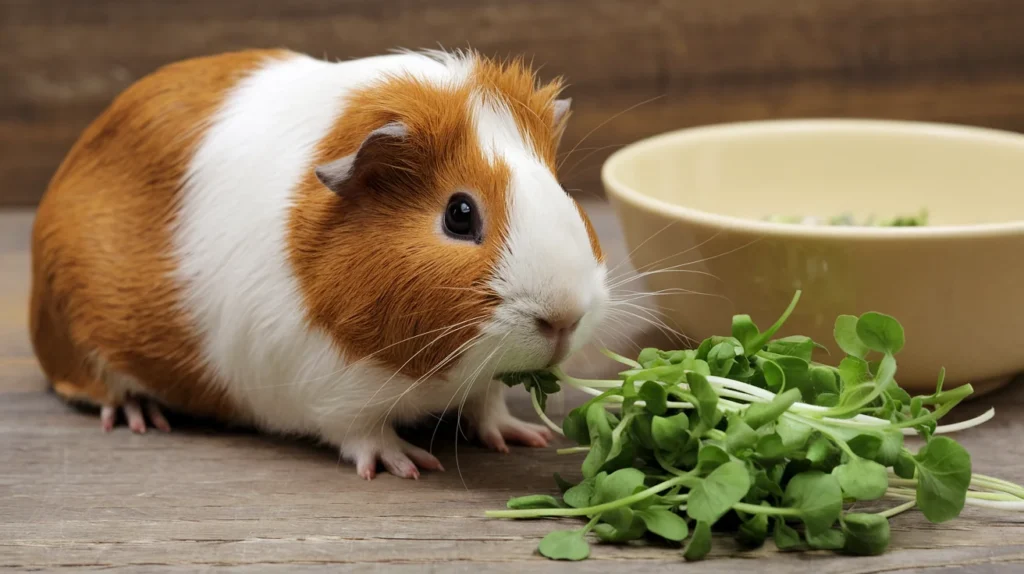If you’re a guinea pig owner, you know how important it is to provide your furry friend with a balanced and nutritious diet. One question that often comes up is: Can guinea pigs eat cress? The short answer is yes, but there’s a lot more to know before you start adding this leafy green to your pet’s menu. In this comprehensive guide, we’ll dive deep into the nutritional benefits of cress, how to feed it safely, and what to watch out for. Let’s get started!
What is Cress?
Cress is a fast-growing, leafy green that belongs to the Brassicaceae family. It’s often used in salads, sandwiches, and garnishes due to its peppery flavor and high nutrient content. There are several types of cress, including:
- Garden Cress: The most common variety, often found in grocery stores.
- Watercress: Grows in water and has a slightly stronger taste.
- Curly Cress: Known for its frilly leaves and mild flavor.
Cress is packed with vitamins and minerals, making it a popular choice for both humans and pets. But is it safe for guinea pigs? Let’s find out.
Can Guinea Pigs Eat Cress?
Yes, guinea pigs can eat cress, but moderation is key. Cress is non-toxic and offers several health benefits, but it also contains compounds that can be harmful if fed in large quantities. Here’s what you need to know:
- Why It’s Safe: Cress is rich in Vitamin C, which is essential for guinea pigs since they can’t produce it on their own. It also provides other nutrients like Vitamin K, calcium, and antioxidants.
- Potential Risks: Cress contains oxalates, which can bind to calcium and lead to bladder or kidney stones if overfed. It’s also relatively high in calcium, so it should be given in moderation to avoid health issues.
Nutritional Benefits of Cress for Guinea Pigs
Cress is a nutritional powerhouse for guinea pigs. Here’s a breakdown of its key nutrients and how they benefit your pet:
Vitamin C
- Guinea pigs need 10-30 mg of Vitamin C daily to prevent scurvy, a common health issue in these animals.
- Cress provides a good amount of Vitamin C, helping to boost your pet’s immune system and overall health.
Vitamin K
- Supports blood clotting and bone health.
- Essential for guinea pigs recovering from injuries or surgeries.
Calcium
- Important for strong bones and teeth.
- However, too much calcium can lead to bladder stones, so portion control is crucial.
Antioxidants
- Help combat free radicals and reduce inflammation.
- Promote a healthy coat and skin.
Low in Sugar
- Unlike some fruits and vegetables, cress is low in sugar, making it a great option for maintaining a healthy weight.
Nutritional Comparison Table: Cress vs. Other Greens
| Nutrient | Cress (per 100g) | Romaine Lettuce (per 100g) | Spinach (per 100g) |
|---|---|---|---|
| Vitamin C | 69 mg | 4 mg | 28 mg |
| Vitamin K | 541 mcg | 102 mcg | 483 mcg |
| Calcium | 81 mg | 33 mg | 99 mg |
| Oxalates | Moderate | Low | High |
As you can see, cress is a nutrient-dense option, but it’s important to balance it with other greens to avoid overloading on calcium and oxalates.
How to Safely Feed Cress to Guinea Pigs
Feeding cress to your guinea pig is simple, but there are a few guidelines to follow to ensure their safety and health:
Serving Size
- Offer 1-2 tablespoons of cress 2-3 times a week.
- This ensures your guinea pig gets the benefits without overloading on calcium or oxalates.
Preparation
- Wash Thoroughly: Rinse the cress under cold water to remove dirt, pesticides, or chemicals.
- Chop into Small Pieces: This makes it easier for your guinea pig to eat and digest.
- Serve Fresh: Only offer fresh cress, as wilted or spoiled greens can cause digestive issues.
Mixing with Other Veggies
- Combine cress with other guinea pig-friendly vegetables like:
- Bell peppers (high in Vitamin C)
- Cucumbers (hydrating and low in sugar)
- Carrots (in moderation, due to sugar content)
What to Avoid
- Wilted or Spoiled Cress: Always check for freshness.
- Overfeeding: Stick to the recommended portion size to prevent health issues.
Risks and Considerations
While cress is generally safe for guinea pigs, there are a few risks to keep in mind:
High Calcium Content
- Overfeeding cress can lead to bladder or kidney stones, especially in guinea pigs prone to these conditions.
- Monitor your pet for signs of discomfort, such as straining to urinate or blood in the urine.
Oxalates
- These compounds can bind to calcium and form crystals, increasing the risk of stones.
- Rotate cress with other low-oxalate greens like romaine lettuce or cilantro.
Pesticides
- Always choose organic cress or wash it thoroughly to remove any chemical residues.
Conclusion
Cress is a safe and nutritious treat for guinea pigs when fed in moderation. It’s packed with essential vitamins and minerals, but it’s important to balance it with other greens to avoid health issues. By following the guidelines in this article, you can safely add cress to your guinea pig’s diet and keep them happy and healthy.
Final Tip: Always observe your guinea pig after introducing new foods. If you notice any signs of discomfort or digestive issues, consult your veterinarian.
Have you tried feeding cress to your guinea pig? Share your experience in the comments below
Frequently Asked Questions (FAQs)
Can Baby Guinea Pigs Eat Cress?
Yes, but in smaller amounts. Baby guinea pigs have sensitive digestive systems, so introduce cress gradually and monitor their reaction.
Can Guinea Pigs Eat All Types of Cress?
Yes, guinea pigs can eat garden cress, watercress, and curly cress. Just ensure it’s fresh and properly washed.
What If My Guinea Pig Doesn’t Like Cress?
Try mixing it with their favorite veggies or introducing it slowly. Not all guinea pigs have the same preferences, so don’t force it.

